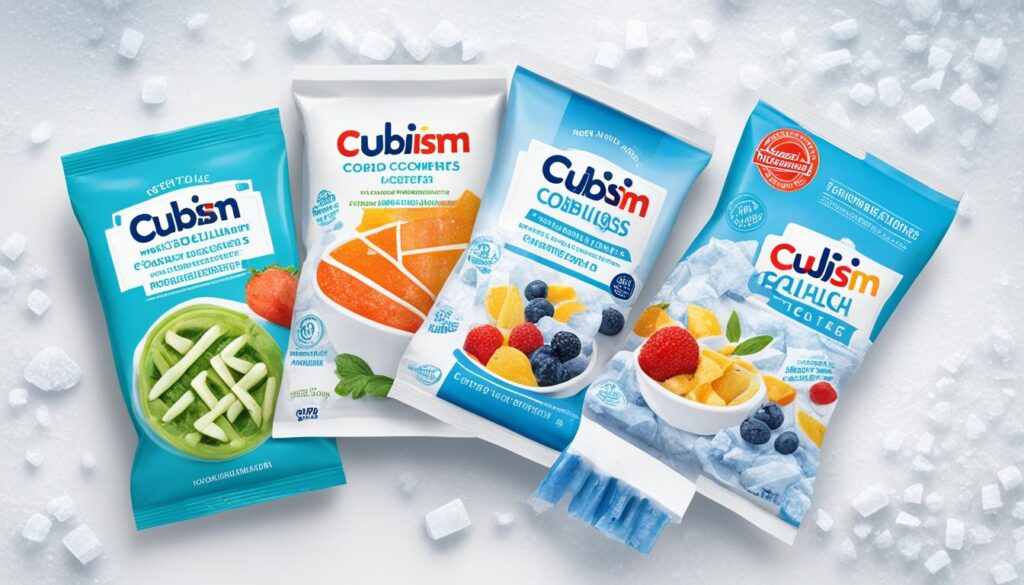Private label frozen food can keep its nutritional benefits, often rivaling fresh produce. Foods are frozen at the best time, keeping vitamins and minerals locked in. This creates frozen meals as nutritious as fresh ones.
To keep the food nutrients, choose items that are not highly processed. Also, think about the best way to store them. This advice comes from the Academy of Nutrition and Dietetics. They say this helps us eat healthier.
Frozen foods are also good for our wallets and the planet. They cost less and help reduce food waste. This makes them a smart pick for staying healthy and being eco-friendly.
Introduction to Nutritional Value Challenges in Frozen Foods
Frozen foods have changed how we use Retail Food Products. They offer an easy way to prepare meals that’s still full of nutrition. Knowing how freezing affects nutrients is key for shoppers and food makers.
The Freezing Process
Freezing food when it’s freshest keeps its vitamins and minerals. It’s like locking in the nutrients at their best. But, how foods freeze and the size of ice crystals matter a lot. This affects the food’s look and taste. Quick freezing used by many brands aims to keep foods healthy and tasty.
Impact on Specific Nutrients
Not all nutrients survive freezing the same way. Water-soluble vitamins, like Vitamin C and B vitamins, are hit hardest. Yet, careful preparation and new freezing methods can keep these nutrients. This means frozen foods can be as good for you as fresh foods. It helps you eat a balanced diet.
Factors Affecting Nutritional Value in Private Label Frozen Food
It’s vital to know what affects the nutritional value of private label frozen foods for healthier picks. How these foods are made and what they’re made of are key. They determine how good for you the food is.
The first steps in making frozen meals matter a lot. Freezing them quickly when they are most nutritious keeps food healthy. But, too much salt and sugar can make them less so. Reading labels is a must. Aim to buy meals with fewer extra ingredients for better health.
The ingredients in these meals also make a big difference. Choosing foods that are not heavily processed or full of bad stuff keeps nutrition high. Stay away from dishes with lots of preservatives or fake flavors. These can harm the food’s nutrients.
To wrap up, consider how foods are made, what they’re made of, and any extras. This approach guides people to pick better items in the freezer section. By focusing on quality, we can enjoy convenient meals that are also good for us.
Comparative Analysis: Fresh vs. Frozen Food Nutritional Value
A study looks at how nutrients in fresh and frozen food change over time. Fresh fruits and veggies start with lots of nutrients. But, they can lose some during transport and storage. Frozen ones keep their nutrients better because they are frozen right after picking.
Fresh Produce Nutrient Retention
Right after they are picked, fresh produce has the most nutrients. But, if not eaten quickly, they can lose these nutrients. Vitamins like C and B are examples. They can lose their strength if not eaten fresh.
Frozen Fruits and Vegetables
Freezing fruits and veggies right away keeps their nutrients well. This means frozen foods can be just as healthy as fresh ones. This makes it easier to eat your favorite foods all year round.
Impact on Protein and Seafood
Freezing protein and seafood can keep them healthy to eat. The right freezing process avoids freezer burn. It keeps their taste, texture, and nutrients well.
Both fresh and frozen food have good points. But, frozen food prepared well at stores can be a great choice. It stays good for a long time in your kitchen.
Best Practices for Maintaining Nutritional Value in Frozen Foods
Keeping frozen food’s nutrition is key and involves a few important steps. Both consumers and makers can use these practices. They help keep the meals healthy and delicious.
Proper Freezer Choices
Choose top-notch freezers to keep meals full of nutrients. Look for freezers that can control the temperature well. Models with precise thermostats are particularly beneficial. They stop temperature swings which can harm the food.
When in the store, pick frozen foods that look well-preserved. This means they’ve likely been kept at the right temperature.
Minimizing Nutrient Loss During Processing
Loss of nutrients during freezing can be lessened. Freeze food quickly right after processing. Flash freezing techniques often yield the best results. They keep ice crystals small, saving the food’s texture and nutrients.
Brands that use modern freezing methods offer better quality. They keep more nutrients locked in their food.
Storage and Re-Freezing
To keep food nutrients, store it right and handle it carefully. Keep the freezer at a steady temperature and don’t pack it full. Be careful with thawing and refreezing – this can harm the food.
Plan meals to avoid a need to refreeze. This keeps the food as nutritious as possible.
By using these strategies, everyone can get the most out of frozen meals. This ensures they are not just convenient but also healthy.
Conclusion
Private label frozen foods strike a good balance between being easy and healthy. Freezing food at its best keeps its key vitamins and minerals. This means people can eat well any time they want.
To pick the healthiest frozen items, look for ones with less processing and no extra bad stuff. Know how to store and handle frozen food correctly helps keep its goodness. This makes it easier for us to enjoy the food in the frozen section.
Brands that focus on quality in how they make and store food lead in offering good and green choices. They use new ideas and follow top steps to give us frozen meals that are both good and good for the environment. Everyone’s effort, from smart shoppers to caring brands, supports a better way to eat that lasts.

